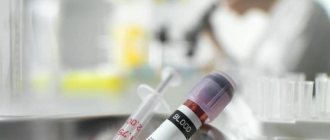Types of diseases
This syndrome can be either primary (genetically determined) or secondary (appears due to external factors or diseases).
Primary immunodeficiency in children - what is it and where does it come from?
Congenital immunodeficiency (ID) in a child is something that develops due to genetic factors; these are primary disorders of the immune system. As a result, severe infections develop that quickly become chronic, and organs and tissues are affected by inflammatory processes. Without treatment, primary immunodeficiency leads to death in children from complications of various infectious diseases.
Symptoms of primary immunodeficiency may not be detected in children because the disease does not have unique features. This may be a simple but often recurring infection, for example of the lungs or ENT organs, or problems with the gastrointestinal tract, inflammation of the joints. Often neither parents nor doctors realize that all these problems are the result of a defect in the child’s immune system. Infectious diseases become chronic, complications appear, and there is no response to a course of antibiotics. Typically, severe forms of immunodeficiency are visible immediately after the birth of the baby or after some time. Source: Doan Thi Mai Recurrent infections in children - the risk of immunodeficiency // Pediatrician, 2021, vol. 8, special issue, pp. 109-110
It is important to distinguish primary immunodeficiency from AIDS. The second is a viral, acquired disease, and the primary form is already “implanted” into the body due to genetic defects.
Why does a child develop secondary immunodeficiency, and what is it?
Such a disease is also a disorder in the functioning of the immune system; it appears in children and adults and is not the result of defects in genes. Secondary immunodeficiency can be caused by a number of factors - external and internal. Any external unfavorable factors that disrupt the metabolic process in the body can lead to the development of such a pathology. The most common of them:
- poor environment, dirty air;
- ionizing radiation, microwave exposure;
- acute poisoning in chronic form;
- long course of certain medications;
- chronic fatigue, stress. Source: M.V. Kudin, S.A. Sergeeva, A.V. Skripkin, Yu.N. Fedorov Prevention of morbidity in children with secondary immunodeficiency in disadvantaged environmental regions // Bulletin of VolSMU, 2009, No. 1(29), pp. 87-95
All these factors have a complex effect on the body and all its systems, including the immune system. And such as ionizing radiation, selectively inhibit the hematopoietic system. People living in conditions of environmental pollution have reduced immunity, they are more likely to suffer infections, and the risk of developing cancer increases. .
Immunoglobulin A, IgA
IgA immunoglobulins are proteins that represent a class of A antibodies that provide local immunity. In the human body, they are presented in the form of two fractions: serum, which provides local immunity, and secretory (contained in milk, secretions of the intestinal and respiratory tract, saliva, tear fluid), which, together with nonspecific immunity factors, create protection of the mucous membranes from microorganisms and viruses. By binding to microorganisms, IgA class antibodies delay their attachment to the cell surface. A decrease in IgA content indicates a deficiency of humoral and local immunity and is observed in: 1) Diseases leading to depletion of the immune system:- Neoplasms of the immune system;
- Condition after removal of the spleen;
- Intestinal and renal protein loss syndromes;
- Treatment with cytostatics and immunosuppressants;
2) Acute viral and chronic bacterial infections.
An increase in concentration may indicate acute and chronic infectious processes (parasitic, fungal, bacterial), liver diseases, systemic lupus erythematosus, myeloma, monoclonal gammopathy. A decrease in content occurs in diseases that lead to depletion of the immune system, acute viral infections.
Content increase:
- Chronic inflammatory processes.
- Hepatitis and cirrhosis of the liver.
- Autoimmune processes.
- Enteropathies.
- Wiskott–Aldrich syndrome.
- Multiple myeloma (IgA type).
- Asymptomatic monoclonal (IgA) gammopathy.
- Respiratory tract diseases.
- Alcoholism.
- Cystic fibrosis.
Reducing content:
Acquired deficiency:
- Neoplasms of the lymphatic system.
- Condition after splenectomy.
- Loss of protein through the kidneys and intestines (with entero- and nephropathies).
- Treatment with immunosuppressants, cytostatics.
- Pernicious anemia (hemoglobinopathy).
- Atopic dermatitis.
- Exposure to ionizing radiation.
Congenital deficiency:
- Bruton's aggammoglobulinemia (congenital deficiency of humoral immunity).
- Ataxia-telangiectasia (Louis-Bar syndrome).
Other reasons:
- Long-term exposure to benzene, toluene, xylene;
- Taking dextran, methylprednisolone, estrogens, carbamazepine, valproic acid, gold preparations.
As a result of strong physical and psycho-emotional stress, leading to stress, the level of immunoglobulins can change as much as any other indicator (tens of times). Their content in the blood depends not only on their production, but also on their ability to be adsorbed on circulating cells. In this case, a dynamic equilibrium is formed, for the shift of which minimal changes in the cellular and humoral composition and physicochemical characteristics of the blood plasma are sufficient. In healthy people and patients, there is no positive relationship between immunoglobulins and B lymphocytes.
Only very strong changes in immunoglobulin levels can be taken into account by the doctor when assessing the patient's condition.
Diagnostics of ID
A family history and complaints of the child (if he is not a newborn), an examination, as well as a number of laboratory tests are collected: molecular genetics, clinical blood test, etc.
Important! If the family already has a child with primary immune deficiency, then prenatal diagnosis is extremely important when carrying a second one.
Signs and symptoms of primary immunodeficiency are detected in children already in the first weeks of life. When a doctor collects anamnesis, he pays special attention to the frequent incidence of viruses and bacterial infections, to heredity aggravated by disorders of the immune system, to congenital malformations.
Often such pathology is detected much later and by chance, when other tests are performed.
The main methods for diagnosing both congenital and acquired disorders of the immune system:
- examination of the child, during which special attention is paid to the condition of the skin, as there may be fungal infections, erosions, dystrophy, ulcers, swelling of different parts of the body;
- blood tests - pathology is indicated by a violation of the leukocyte formula;
- special immunological studies;
- molecular genetic analysis.
general characteristics
Serum IgA makes up 10-15% of the total amount of immunoglobulins and is synthesized by mature B lymphocytes. This class of immunoglobulins includes antibodies that provide local immunity: protection of the respiratory, genitourinary and gastrointestinal tract from infections. The main amount of IgA is not found in the serum, but on the surface of the mucous membranes in the form of secretory IgA. Activates complement via the alternative pathway. Half-life is 6-7 days. IgA is thymus-independent and its independent synthesis at a very early age is insufficient. The intake of IgA with colostrum and mother's breast milk prevents the early colonization of the newborn's intestines by bacteria. IgA deficiency leads to repeated infections, autoimmune disorders, and allergies. Determination of the content of serum immunoglobulin A has clinical and diagnostic significance for: chronic diarrhea, malabsorption syndrome, recurrent bacterial respiratory infections, otitis, meningitis, bronchial asthma, anaphylactic post-transfusion reactions, DTD (systemic lupus erythematosus, rheumatoid arthritis, dermatomyositis), tumor diseases of the lymphoid system (myeloma, leukemia, lymphoma, reticulosarcoma), chronic hepatitis, liver cirrhosis.
Treatment of the disease
The primary form of the disease involves:
- avoiding contact with possible sources of infection.
- during periods of remission, the child can and should lead a normal life, maintain hygiene, and attend an educational institution.
- if there is a threat of infection, broad-spectrum antibiotics are prescribed.
- If there is an effect, the child should be treated for about 3-4 weeks while taking antiviral and antifungal agents. Sometimes antimicrobial treatment lasts for years.
Immunodeficiency can be corrected using immunoreconstruction, replacement treatment, and immunomodulators. In the primary form of the pathology, immunoglobulins are used; in the secondary form, immunotropics, replacement therapy, and immunization are used.
In case of primary pathology, it is extremely important to isolate the child from all sources of infection. When there are no exacerbations of infections, the child can lead a normal life. In case of primary immunodeficiency against the background of a general deficiency of antibodies, children cannot be vaccinated against:
- measles;
- mumps;
- polio;
- rubella;
- chicken pox;
- tuberculosis.
Those living with the child can only be vaccinated with inactivated vaccines.
Antimicrobial treatment consists of taking broad-spectrum antibiotics. If there is no rapid response to therapy, the drug is changed. If there is an effect, then the child should take the antibiotic for at least 3-4 weeks. Medicines are administered intravenously or parenterally. At the same time, antifungal drugs are prescribed and, if indicated, antiviral, antiprotozoal, and antimycobacterial drugs. Antimicrobial therapy can even be lifelong.
For influenza against the background of ID, oseltamivir, remantadine, zanamivir, amantadine, and neuraminidase inhibitors are usually prescribed. If a child gets chickenpox or herpes, acyclovir is prescribed; parainfluenza requires taking ribavirin. Before dental treatment or surgery, the child must take a course of antibiotics to prevent infection.
In cases of severe secondary or primary T-cell ID, Pneumocystis pneumonia should be prevented, depending on blood test results. For this, doctors usually prescribe trimethoprimsulfomethaxozole.
Important! Any medications should only be prescribed by a doctor; self-medication is deadly for a child!
Methods for correcting immune deficiency:
- replacement treatment;
- reconstruction of immunity;
- immunomodulation.
Immunoreconstruction involves transplanting bone marrow or stem cells obtained from umbilical cord blood. In case of primary ID, replacement therapy most often involves taking allogeneic immunoglobulin, which in recent years has been commonly administered intravenously.
Treatment of children with primary ID with common defects in antibody production
In this case, replacement therapy with immunoglobulins, which are administered intravenously, and antibiotics is carried out. Immunoglobulins are administered once every three to four weeks for life. Continuous antibiotic therapy is needed to prevent bacterial infections.
When a bacterial infection worsens, broad-spectrum antibiotics administered parenterally are prescribed. In case of hyper IgM syndrome and common variable immune deficiency (CVID), you need to constantly take antifungal and antiviral drugs. They can be assigned in courses. This is determined by the doctor individually. If a child has X-linked hyper IgM syndrome, then a bone marrow transplant from an HLA-identical donor is indicated.
Indications for use
1. Recurrent bacterial respiratory infections (sinusitis, pneumonia), as well as otitis and meningitis, bronchial asthma.2. Chronic diarrhea, malabsorption syndrome. 3. Anaphylactic post-transfusion reactions. 4. Louis-Bar syndrome (ataxia - telangiectasia). 5. Tumor diseases of the lymphoid system (myeloma, leukemia, lymphoma, reticulosarcoma).6. Diffuse connective tissue diseases (rheumatoid arthritis, systemic lupus erythematosus, dermatomyositis).7. Chronic hepatitis, liver cirrhosis.
Treatment methods for secondary ID
Immunotropic therapy is mainly used, which can be of different directions:
- active immunization;
- replacement therapy;
- taking immunotropics.
The choice of immunotropic therapy depends on how acute the inflammatory-infectious process is and what immunological defect is identified. When the symptoms of the disease subside, vaccine therapy can be used for prevention.
Immunoglobulins administered intravenously are used as replacement therapy. Their main active ingredient is special antibodies obtained from donors. Immunoglobulins containing only IgG are often prescribed.
Immunotropic treatment of secondary ID
Using immunomodulators, the effectiveness of antimicrobial therapy can be increased. Immunomodulators should be part of complex therapy together with etiotropic treatment of infection. The doctor calculates the regimen and dosage individually.
Immunological monitoring should be carried out while taking immunomodulators. If the infection is in an acute stage, immunomodulators are used with caution. Otherwise, you can cause a severe general inflammatory response and septic shock as a result. Source: G.A. Samsygina, G.S. Koval Problems of diagnosis and treatment of frequently ill children at the present stage // Pediatrics, 2010, v. 89, no. 2, pp. 137-145
Prevention methods
ID is easier to prevent than to treat. It is important to remember that the condition of the child directly depends on how correctly the pregnancy was planned. If one of the parents has problems with immunity, he must undergo special procedures to exclude a similar pathology in the child.
In the first six months of life, only breastfeeding is recommended, because breast milk contains all the necessary elements that contribute to the development of full immunity. If there is no lactation, you need high-quality artificial mixtures, but always supplemented with multivitamins.
Sources:
- Doan Thi Mai. Recurrent infections in children - the risk of immunodeficiency // Pediatrician, 2021, v. 8, special issue, pp. 109-110.
- M.V. Kudin, S.A. Sergeeva, A.V. Skripkin, Yu.N. Fedorov. Prevention of morbidity in children with secondary immunodeficiency in disadvantaged ecological regions // Bulletin of VolSMU, 2009, No. 1(29), pp. 87-95.
- G.A. Samsygina, G.S. Koval. Problems of diagnosis and treatment of frequently ill children at the present stage // Pediatrics, 2010, v. 89, no. 2, pp. 137-145.
The information in this article is provided for reference purposes and does not replace advice from a qualified professional. Don't self-medicate! At the first signs of illness, you should consult a doctor.
Prices
| Name of service (price list incomplete) | Price |
| Appointment (examination, consultation) with an allergist-immunologist, primary, therapeutic and diagnostic, outpatient | 1750 rub. |
| Consultation (interpretation) with analyzes from third parties | 2250 rub. |
| Prescription of treatment regimen (for up to 1 month) | 1800 rub. |
| Prescription of treatment regimen (for a period of 1 month) | 2700 rub. |
| Consultation with a candidate of medical sciences | 2500 rub. |
| Allergen-specific immunotherapy (ASIT) - maintenance course (excluding the cost of the drug) | 8100 rub. |








